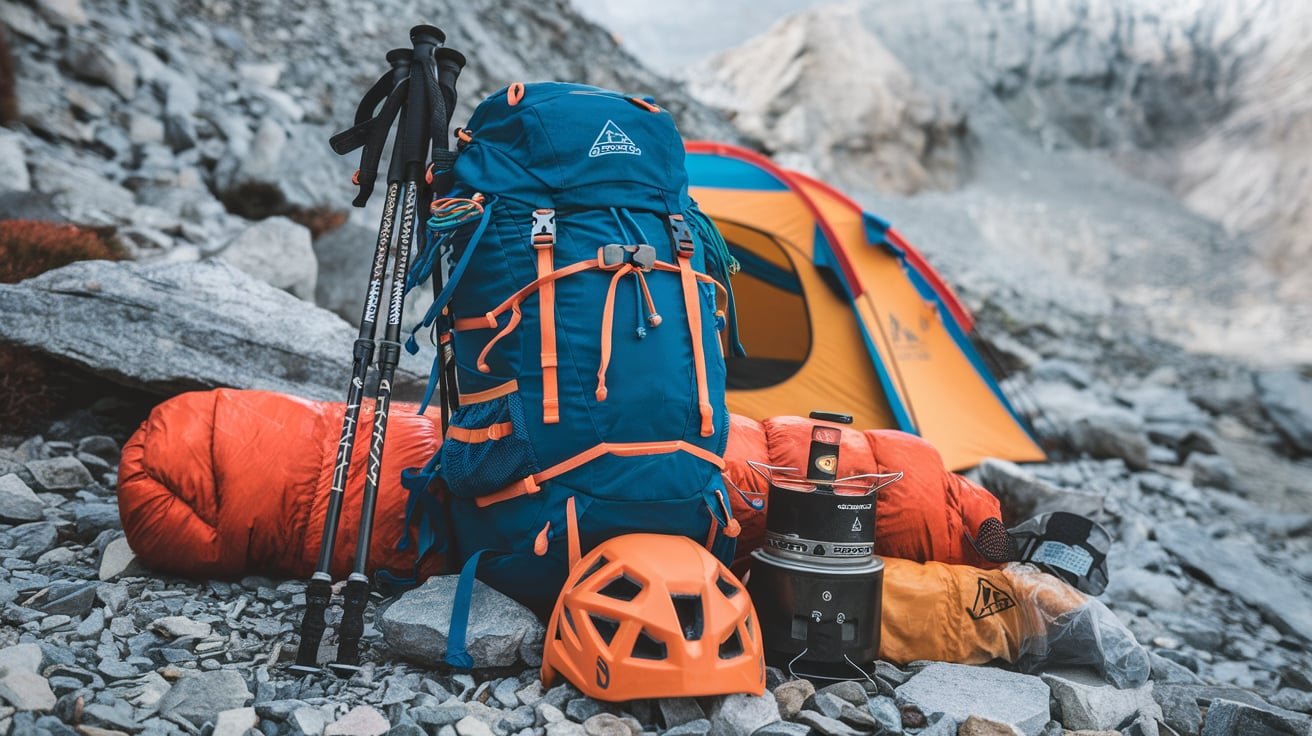When preparing for the Everest Base Camp trek, having the right gear and supplies is crucial for a successful and comfortable journey. The trek involves navigating high altitudes and variable weather conditions, so packing wisely can make a significant difference in your overall experience.
First and foremost, focus on clothing that provides both warmth and breathability. Layering is key due to the wide range of temperatures you’ll encounter. Begin with a dampness wicking base layer to get sweat far from your skin. On top of this, wear an insulating mid-layer, such as a fleece or down jacket, which provides warmth. A waterproof and windproof outer layer, like a shell jacket and pants, is essential to protect against snow, rain, and wind. Also, pack a pair of thermal gloves, a hat, and a neck gaiter to keep extremities warm in freezing conditions.
Footwear is one more basic part of your pressing rundown. Sturdy, waterproof trekking boots with good ankle support are essential, as the trail can be uneven and rugged. Bring multiple pairs of moisture-wicking socks, and consider carrying a few blister prevention tools like moleskin or blister pads.
For sleeping comfort, a lightweight sleeping bag rated for temperatures down to at least -10°C (14°F) is recommended, as nights can be quite cold. A camping bed liner can add additional glow and cleanliness.Trekking to EBC poles can help with stability on uneven terrain and reduce strain on your knees during descents.
Pack essential personal items such as a high-quality sunscreen, lip balm with SPF, and a reusable water bottle or hydration system to stay hydrated. A headlamp with extra batteries is necessary for navigating in the dark, and a multi-tool or knife can be useful for various tasks.
First aid supplies are vital for addressing minor injuries or ailments. Include a basic first aid kit with items like bandages, antiseptic wipes, pain relievers, and altitude sickness medication. Personal hygiene items, such as biodegradable soap and hand sanitizer, help maintain cleanliness on the trail.
Additionally, pack snacks and energy bars to keep your energy levels up during long trekking days. A compact camera or smartphone can capture the stunning scenery, but remember to keep electronics and valuables secure and protected from the elements.
When deciding what to leave behind, avoid bringing unnecessary items that can add weight and bulk to your pack. Luxuries such as extra gadgets or non-essential clothing can weigh you down and make the trek more challenging. Additionally, avoid bringing heavy books, excessive toiletries, or items that could be difficult to maintain in the rugged conditions.
In summary, packing for the Everest Base Camp trek requires careful consideration of essential clothing, gear, and personal items. Prioritize lightweight, versatile, and durable items that cater to the extreme conditions and varied terrain of the trek, ensuring a more comfortable and successful adventure.
Introduction to Packing for the Trek
Packing for the Everest Base Camp trek requires careful planning and consideration to ensure you have everything needed for a safe and comfortable journey. The trek spans diverse terrains and experiences varying weather conditions, from sunny days to freezing temperatures. Therefore, packing appropriately is crucial for handling these challenges effectively. Your packing list should include clothing suited for layering, durable footwear, and essential gear for navigation and comfort. Proper preparation also involves understanding the weight limits for trekking and packing only the most necessary items to avoid overburdening yourself. By selecting the right gear and supplies, you can enhance your trekking experience and focus on enjoying the stunning landscapes and cultural experiences along the way.
Essential Clothing Items
When trekking to Everest Base Camp, clothing choices are critical for managing the range of temperatures and weather conditions encountered on the trail. Start with a moisture-wicking base layer to keep sweat off your skin, followed by insulating mid-layers like a fleece or down jacket to provide warmth. An outer layer, such as a waterproof and windproof jacket and pants, is essential to protect against snow, rain, and wind. Additionally, pack a thermal hat, gloves, and a neck gaiter to safeguard against extreme cold. Proper layering allows you to adjust your clothing as needed, ensuring comfort throughout the trek. It’s also wise to bring a few pairs of quick-drying, lightweight hiking pants and shirts, as well as additional underwear and socks. Opt for clothing that is both functional and versatile to adapt to changing weather conditions and trek demands.
Footwear: Choosing the Right Boots
Selecting the right footwear is essential for a comfortable and safe trek to Everest Base Camp. Opt for sturdy, waterproof trekking boots with excellent ankle support to handle the rugged terrain and uneven surfaces. Boots should be well-fitted to prevent blisters and provide ample support, especially during descents. It’s advisable to break in your boots before the trek to avoid discomfort. Additionally, consider bringing several pairs of moisture-wicking socks to keep your feet dry and comfortable. Lightweight, breathable, and quick-drying socks help prevent blisters and manage moisture. Trekking poles can also be beneficial for added stability and reducing strain on your knees. Proper footwear ensures a smoother trekking experience, minimizing the risk of injury and enhancing your overall comfort on the trail.
Sleeping Gear for Comfort
Sleeping gear is crucial for restful nights during the Everest Base Camp trek, where temperatures can drop significantly. A high-quality sleeping bag rated for temperatures as low as -10°C (14°F) is essential to stay warm and comfortable. Choose a sleeping bag that is both lightweight and compressible for easy packing. A camping bed liner can add additional glow and further develop cleanliness. Additionally, consider bringing a lightweight, inflatable sleeping pad for added insulation and comfort. Sleeping pads provide cushioning and help insulate you from the cold ground. Ensure your sleeping gear is suitable for the cold nights at high altitudes, as quality rest contributes to your overall trekking performance and acclimatization.
Navigation Tools: Maps and GPS
Accurate navigation is vital for a successful Everest Base Camp trek. A detailed trekking map is essential for understanding the route, identifying landmarks, and planning daily segments of your journey. Alongside a physical map, a GPS device or a smartphone with offline mapping apps can enhance navigation, providing real-time location tracking and route guidance. Ensure that your GPS device is fully charged and bring extra batteries if needed. Additionally, a compass can be a useful backup navigation tool. Having reliable navigation tools helps ensure you stay on track, avoid getting lost, and navigate safely through the varied terrain of the trek. Proper navigation preparation contributes to a safer and more enjoyable trekking experience.
Cooking and Eating Equipment
Cooking and eating equipment is essential for managing meals during the Everest Base Camp trek, as there are limited dining facilities along the route. A compact, lightweight camping stove is crucial for preparing hot meals and beverages. Choose a stove that is easy to operate and reliable in varying weather conditions. Along with the stove, bring a fuel supply that meets the trek’s duration. A set of lightweight, durable cookware, including a pot, pan, and utensils, is necessary for meal preparation. Don’t forget to pack a multi-use knife or tool for food prep. Additionally, bring collapsible or compact dishes and utensils, such as a spork, to save space and weight. A small, portable sponge or cloth for washing dishes and a secure, sealable bag for trash are also important to maintain cleanliness and environmental responsibility.
Hydration Systems and Water Purification
Staying hydrated is crucial during the Everest Base Camp trek Itinerary due to the increased physical exertion and dry, high-altitude environment. A hydration system, such as a water bladder with a hose, allows for convenient access to water while trekking. Ensure it has sufficient capacity to meet daily hydration needs. Additionally, carry a high-quality, portable water filter or purification tablets to treat water from natural sources, reducing the risk of waterborne illnesses. It’s advisable to bring a lightweight water bottle as a backup for easy access and to store treated water. Regular hydration helps maintain energy levels and supports acclimatization, making these systems an essential part of your trekking gear.
First Aid Kit Essentials
A well-stocked first aid kit is crucial for addressing minor injuries and health issues during the Everest Base Camp trek. Include basic supplies such as adhesive bandages, antiseptic wipes, and gauze for treating cuts and abrasions. Pain relievers like ibuprofen or acetaminophen are useful for managing headaches and muscle aches. Add blister treatment items, such as moleskin or blister pads, to prevent and manage blisters from hiking. Include altitude sickness medication, as recommended by a healthcare professional, and any personal prescription medications. A thermometer, tweezers, and a small pair of scissors can also be beneficial. Properly packed and accessible first aid supplies ensure you can handle minor medical issues effectively and maintain well-being throughout the trek.
Personal Hygiene Items
Maintaining personal hygiene is important for comfort and health during the Everest Base Camp trek. Pack biodegradable soap for washing hands and body, as well as hand sanitizer for situations where water is not available. Bring a quick-dry, compact towel for personal use, and consider carrying travel-sized toiletries to minimize bulk. Toothbrush, toothpaste, and any personal hygiene products should be included. Additionally, a small toiletry kit or pouch helps keep these items organized and easily accessible. Feminine hygiene products should also be part of your kit, with a plan for proper disposal in a way that respects the environment. Proper hygiene practices are essential for comfort and health during your trek.
Photography Equipment
Capturing the stunning landscapes and memorable moments of the Everest Base Camp trek requires thoughtful selection of photography equipment. A lightweight, high-quality camera with good low-light performance is essential for capturing the varied conditions of the trek. Consider a DSLR or mirrorless camera with interchangeable lenses to adapt to different photographic needs. A versatile zoom lens can be particularly useful for capturing distant landscapes and close-up details. A compact tripod is useful for stability and night photography, such as capturing the starry skies above Everest. Spare batteries and memory cards are crucial to ensure you don’t miss any moments. A protective case or waterproof cover will safeguard your equipment from the elements. Properly packing and using your photography gear helps you document the journey and create lasting memories of your adventure.
Technology: Gadgets and Charging Solutions
When trekking to Everest Base Camp, technology can enhance your experience and keep you connected, but it requires careful management to ensure functionality. Key gadgets include a reliable smartphone with offline maps and a portable charger or power bank to keep it operational in remote areas. Given the limited access to electricity, a solar charger can also be useful for extended treks. A compact, lightweight GPS device is another essential tool for navigation, particularly in areas where trails may not be well marked. Don’t forget a headlamp or flashlight with extra batteries for nighttime use. To ensure your gadgets remain functional and charged, bring the necessary cables and adapters. Opt for durable, weather-resistant cases to protect your devices from the harsh conditions of the trek. Balancing technology use with practicality ensures you stay connected and safe without compromising the trekking experience.
Trekking Poles: Benefits and Options
Trekking poles are a valuable addition to your gear for the Everest Base Camp trek, offering significant benefits for stability and comfort. They help reduce the strain on your knees and joints, particularly during descents, and provide additional support on uneven terrain. Adjustable trekking poles are ideal as they allow for customization to your height and the terrain’s steepness. Look for poles with ergonomic grips and shock absorption features to enhance comfort. Consider lightweight, collapsible models for easy packing and transport. Trekking poles can also assist in maintaining a steady pace and conserving energy by providing extra balance. Proper use of trekking poles, including correct height adjustment and technique, contributes to a safer and more enjoyable trekking experience.
Backpack Selection: Size and Features
Choosing the right backpack is crucial for comfort and convenience during the Everest Base Camp trek. A backpack with a capacity of 40 to 60 liters is typically suitable, providing enough space for your gear while remaining manageable. Look for features such as adjustable, padded shoulder straps and a hip belt to distribute weight evenly and reduce strain. A well-designed backpack with multiple compartments helps keep your gear organized and easily accessible. Consider a backpack with hydration reservoir compatibility or external water bottle pockets. Additionally, ensure that the backpack is made of durable, weather-resistant material to protect your belongings from the elements. Proper fit and functionality in your backpack are essential for a comfortable trek, allowing you to carry essential items efficiently.
What Not to Bring: Common Packing Mistakes
Avoiding common packing mistakes is crucial for a successful Everest Base Camp trek. One frequent error is overpacking, which can lead to unnecessary weight and discomfort. Avoid bringing bulky items or non-essential luxuries that can add excess weight to your pack. Items such as excessive toiletries, heavy books, or extra clothing that is not suitable for high-altitude conditions should be left behind. Additionally, steer clear of cotton clothing, which does not wick moisture effectively and can cause discomfort. Avoid bringing high-value items or gadgets that may be difficult to protect and maintain in rugged conditions. By packing only necessary and functional items, you ensure that your trek is more comfortable and manageable.
Conclusion: Final Packing Tips for Success
In conclusion, effective packing for the Everest Base Camp trek involves careful selection of essential gear and mindful organization. Prioritize functional, lightweight items that address the challenges of high-altitude trekking, including appropriate clothing layers, sturdy footwear, and reliable navigation tools. Equip yourself with the necessary technology and charging solutions while avoiding non-essential items that can add unnecessary weight. Properly chosen trekking poles and a well-fitted backpack will enhance your comfort and efficiency. Attention to packing details and avoiding common mistakes ensure a smoother, more enjoyable trek, allowing you to focus on the adventure and the breathtaking landscapes along the way. With thoughtful preparation and strategic packing, you set the stage for a successful Everest Base Camp experience.


